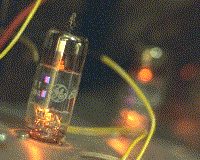Paul's Digital Audio Page
 Paul's Digital Audio Page
Paul's Digital Audio Page
Playing with digital domain compensation
I've been interested for a long time in compensating for the various
linear anomolies (such as speaker or room response) present in all
reproduction systems. You can buy gadgets for this now,
but they are very expensive and besides I want to learn by doing.
I've been able to experiment a little compensating for
a pair of old Altec A7 "Voice of the Theater" horns
in my living room.
I used offline (full-spectrum) or online (1KHz up) digital
32-bit floating point frequency-domain compensation
through a Pentium-90 PC with
one of
Greg Hanssen's
ZA1 S/PDIF interface cards.
So far I've learned that you can get amazing results on the bass.
The A7's have very peaky bass due to their big 15" woofer loaded with a
relatively tiny horn. With compensation it became incredibly smooth.
I was not able to produce decent compensation for mid-high frequencies,
however by doing only phase (not amplitude) compensation at these frequencies
I noticed improved definition.
I also found that compensation around the crossover frequency is
particularly difficult. That was no surprise, and my plan has always
been to biamp with crossover and compensation together
in the digital domain.
My all-digital stereo system
In order to work in the digital domain you have to get all your inputs digital.
Fortunately (sort of) I currently have no high quality analog sources
(I'm all converted to CD, no LP's left.)
I built an automatic digital audio selector and converter which lives in
the TV stand. It automatically selects any live digital input
(CD, laserdisk) and when none are active it converts the TV output from
analog to digital. I use the TV to select analog sources (TV, VCR.)
I don't have an FM tuner connected but haven't really missed it.
Direct Conversion Digital Amp
I'm working on a vacuum tube "amp" that converts directly from
the digital domain
to full power output to the speakers, with no analog gain in between.
Sort of a power DAC.
My design uses a delta/sigma converter chip which outputs a single bit stream per channel.
The bit stream is applied to the grid circuit of TV video amp tubes in parallel.
These tubes were selected because of their excellent combination of
high frequency performance, high gain, relatively high plate dissipation
and low coupling between plate and grid circuit.
The audio output is filtered a little in the plate circuit
and goes through a transformer to the speakers.
This design has several interesting characteristics.
Some are designed in but most are inherent in the circuit topology.
There are a few non-obvious tricks in the design, but the result is straightforward enough.
The only components in the audio path are the tube plates,
a small capacitor, and the output transformer. It is:
-
Insensitive to anomalies in the digital input signal.
-
Independent of tube linearity.
-
Immune to power supply fluctuations.
-
Good isolation between digital and analog sections.
I've completed a
breadboard
which took up several feet of
bench space.
It sounded pretty good, but it wasn't possible to get it very close
to any decent speakers.
Now I'm working on a luggable prototype, the chassis and power supplies
are complete but the project is stalled.
Back to Paul's Home Page
 Paul's Digital Audio Page
Paul's Digital Audio Page Paul's Digital Audio Page
Paul's Digital Audio Page